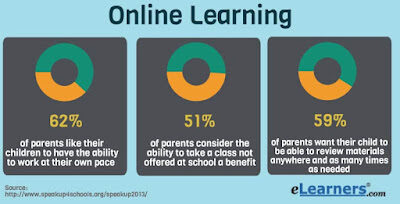Ready for Online Learning: 3 Key Dispositions for Student Success
 Technology integrated teaching and learning can be found in classrooms across the nation, yet digital natives often possess “untutored” habits of mind necessary for successful online learning. As we align our curriculum and prepare our students for college readiness skills, high schools can close the preparedness gap and help to cultivate online learning dispositions.
Technology integrated teaching and learning can be found in classrooms across the nation, yet digital natives often possess “untutored” habits of mind necessary for successful online learning. As we align our curriculum and prepare our students for college readiness skills, high schools can close the preparedness gap and help to cultivate online learning dispositions.
What We Know about Online Courses
 Online courses first began to appear as a viable alternative to traditional coursework in the 1990s. According to the Instructional Technology Council (ITC), online learning is now considered equal to traditional face-to-face education (Goral, 2017). Supporters argue that distance learning enjoys mainstream support pointing to Ivy League institutions such as Harvard and MIT whose open course models are freely available to eager learners (Naidu, 2014). As colleges and universities turn to this mode of instruction, evidence-based research supports best practices in online pedagogy. These practices vary from instructional approaches and strategies more commonly found in high school settings. A current opportunity exists to refine the K-12 teaching and learning experience by preparing students for online courses. Consider a high school student whose assumptions about the learning process are rooted in the traditional classroom resulting in a preparedness gap when the first fully online course is encountered in college (Goral)
Online courses first began to appear as a viable alternative to traditional coursework in the 1990s. According to the Instructional Technology Council (ITC), online learning is now considered equal to traditional face-to-face education (Goral, 2017). Supporters argue that distance learning enjoys mainstream support pointing to Ivy League institutions such as Harvard and MIT whose open course models are freely available to eager learners (Naidu, 2014). As colleges and universities turn to this mode of instruction, evidence-based research supports best practices in online pedagogy. These practices vary from instructional approaches and strategies more commonly found in high school settings. A current opportunity exists to refine the K-12 teaching and learning experience by preparing students for online courses. Consider a high school student whose assumptions about the learning process are rooted in the traditional classroom resulting in a preparedness gap when the first fully online course is encountered in college (Goral)

College is not the only field to adopt online learning. Industries are turning to micro-credentialing and online professional development to encourage self-directed and on-the-go learning for professionals. Students may well encounter the need to stay competitive and certified through online coursework while drawing upon the skillset learned from intentional integration of online learning. College and career readiness standards are ready to absorb units and online preparation courses for our students: particularly our high school students.
As an ITC board member, Professor Lokken studied three problems causing online student retention to lag by 8% compared to traditional courses (Goral, 2016). He points to student’s academic and study habits, maturity level, and a preparedness gap as an explanation. As K-12 institutions, we can directly improve this technology based learning gap with the adoption of a holistic view as we prepare critical thinkers for college and the workforce. If we can model, coach, and guide students through dispositional and operational habits of mind, we can alter assumptions about learning, reorienting standards on what to expect, and how to navigate online academic and certification courses.
Keys to Online Student Learning Dispositions
Gaier (2015) defines learning dispositions as “ A prevailing cognitive and emotional state towards the content being learned and toward the learning process.” Numerous studies have addressed learning dispositions including Gaier and the Habits of Mind Institute founded by Bena Kallick and Art Costa. These studies typically address dispositions that increase academic and social success through growth mindsets (Gaier, 2015). 3 keys represent dispositions useful to student learning to transition to online environments.
-
Learn to develop a habit of ritual organization: using a planner, compare the class syllabus to online communication within the course recording all assignments, due dates, and plans to achieve submission prior to due dates, allotting additional time for any technical difficulties. Few instructors will allow technology or ignorance of expected deadlines to be an excuse for late assignments as the onus is on the student. The successful high school transfer to this type of learning environment prioritizes time management and structures a study of the course itself around that of the content of the course.
-
Learn to value online communication: Instructors spend many hours of instructional design to prepare content and courses for online delivery. In the same way that students learn to adapt from hand-writing essays to typing essays, students must be prepared to transfer learning from the more guided nature of face-to-face interactions to those of the largely independent online environment. They should enter the online course frequently during the week to navigate through modules, announcements, discussions, and assignments. The onus is again on the student to adapt to this format of communication. Students need to be assured that instructors and student service departments are ready to assist in the transition process but attempts to request help must be proactive requests asked in advance of due dates with time to receive assistance and still accomplish the learning.
-
Learn to keep an open mind: High School students accustomed to gentle reminders from dedicated teachers in face-to-face instruction will find it difficult to prioritize and time manage using learning management systems (LMS) like Canvas. It takes time to built familiarity with navigation and course patterns but typically, by week 3 or 4, students should begin to acclimate to the online habits of mind required to be successful. High school instructors should expect to teach the skills of online navigation, formats, and learning while moving slower through content initially to best address student frustration and lack of confidence. High interest assignments that highlight the value of online learning help to peak interest and motivate reluctant learners.
Jaimie Orozco- Jaimie is a current doctoral student and educator with 15 years of experience. Currently, Jaimie works as an Instructional Coach for new teachers, History Department Chair and educator, and a part-time adjunct faculty member. Jaimie is honored to join the 2017 ASCD Emerging Leaders program.
Reference
Gaier, S. (2015). A mindset for learning: The dispositions of academically successful students: The scholarly teacher. Retrieved 24 November 2017, from http://scholarlyteacher.com/2015/07/a-mindset-for-learning-the-dispositions-of-academically-successful-students/
Goral, T. (2016). What we’ve learned about distance education: progress and problems revealed by survey offer guidance for the future of online learning. University Business, (7). 8. Retrieved from www.universitybusiness.com
Naidu, S. (2014, November). Looking back, looking forward: the invention and reinvention of distance education. Distance Education. pp. 263-270. doi:10.1080/01587919.2014.961671.




